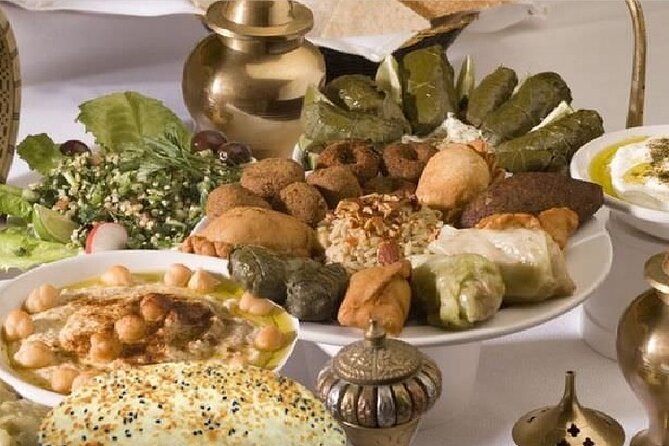Turkish cuisine isn’t just about food; it’s a captivating journey through history that reflects centuries of cultural fusion. With roots tracing back to the Ottoman Empire and influences from Central Asia and the Mediterranean, every dish tells a story. Ingredients like olive oil and yogurt play starring roles, while traditional techniques bring out the best in kebabs and baklava. But what makes it even more intriguing is how regional variations add unique twists to familiar flavors. Curious about the hidden gems and culinary secrets that await?
Good To Know

- Turkish cuisine is a rich blend of influences from the Ottoman Empire, Central Asian nomads, and Mediterranean cultures, reflecting historical migrations and trade.
- Key ingredients include olive oil, yogurt, sumac, red pepper flakes, and bulgur, which are staples in many traditional dishes.
- Popular dishes like kebabs, meze, dolma, pide, and baklava showcase the diverse flavors and culinary techniques unique to various Turkish regions.
- Cooking methods such as grilling, slow cooking, and baking have been passed down through generations, enhancing the flavors and cultural significance of the food.
- Modern Turkish cuisine embraces plant-based ingredients and global influences while maintaining traditional techniques, creating a dynamic and evolving culinary landscape.
Historical Influences on Turkish Cuisine

Drawing on a rich tapestry of history, Turkish cuisine reflects a blend of cultures and traditions that have shaped it over centuries.
The culinary landscape is a delightful mosaic influenced by the Ottoman Empire, Central Asian nomads, and Mediterranean flavors. Each group brought unique ingredients and cooking techniques, creating a vibrant food culture.
For instance, the Ottomans popularized dishes like kebabs and mezes, while Central Asian roots introduced dough-based foods like mantı.
Geographic location plays a significant role too; Turkey bridges Europe and Asia, allowing flavors and practices to intermingle.
It’s no wonder that Turkish cuisine tells a story of migration, trade, and cultural exchange, making every meal not just a feast but a historical journey.
You can also read our reviews of more tours and experiences in Istanbul.
Key Ingredients in Turkish Dishes

Turkish cuisine is brimming with key ingredients that give its dishes a unique flair and depth of flavor. Fresh herbs, spices, and quality produce play pivotal roles in creating the vibrant tastes that define this culinary tradition. Here’s a quick overview of some essential ingredients:
| Ingredient | Description |
|---|---|
| Olive Oil | A staple for cooking and dressing. |
| Yogurt | Used in dips and as a side dish. |
| Sumac | Adds a tangy flavor to salads. |
| Red Pepper Flakes | Provides heat to various dishes. |
| Bulgur | A nutritious base for many meals. |
These ingredients not only enhance the taste but also reflect the rich cultural heritage of Turkey, making every bite a delicious experience.
Traditional Cooking Techniques
Cooking in Turkey isn’t just about the ingredients; it’s also about the methods that bring those vibrant flavors to life.
Traditional cooking techniques play a crucial role in shaping Turkish cuisine. Here are three key methods:
-
Grilling: Whether it’s kebabs or fish, grilling adds a smoky flavor that’s hard to beat.
-
Slow Cooking: Dishes like stews and dolmas benefit from long, slow cooking, allowing flavors to meld beautifully.
-
Baking: Bread and pastries, often baked in stone ovens, showcase the finesse of Turkish baking techniques.
These methods aren’t just about preparation; they’re a cultural expression, passed down through generations.
When you taste Turkish food, you’re not just enjoying a meal; you’re experiencing history and tradition in every bite.
Popular Turkish Dishes
When you dive into the world of Turkish cuisine, you’ll quickly discover an array of mouthwatering dishes that reflect the country’s rich cultural tapestry.
One standout is kebab, which comes in countless varieties, showcasing grilled meats marinated in spices.
Then there’s meze, a delightful assortment of small dishes perfect for sharing, featuring everything from hummus to stuffed grape leaves.
Don’t forget about dolma, which are grape leaves stuffed with rice and spices, and the iconic pide, a Turkish flatbread topped with various ingredients.
And, of course, everyone loves baklava—sweet, flaky pastry layered with nuts and honey.
Each dish tells a story, inviting everyone to explore the flavors that make Turkish cuisine truly unforgettable.
Regional Variations of Cuisine

The diverse regions of Turkey each boast their own unique culinary traditions, creating a vibrant tapestry of flavors and ingredients.
Travelers can expect to find:
-
Aegean Delights: Featuring olive oil-based dishes and fresh seafood, this region emphasizes health and freshness.
-
Central Anatolian Classics: Known for hearty meals like manti (Turkish dumplings) and kebabs, it reflects the agricultural richness of the land.
-
Eastern Wonders: Spices take center stage here, with dishes like kebab and dolma highlighting robust flavors and traditional cooking methods.
From the spicy stews of the East to the zesty salads of the Aegean, each area’s cuisine tells a story of its climate, culture, and history, making Turkish food an exciting journey for any palate.
- #1 Rated Istanbul Party Pub Crawl W Party Bus/Sultanahmet&Taksim
- Bosphorus Yacht Cruise With Stopover on the Asian Side – (Morning or Afternoon)
- Private Transfer From Istanbul Airport to Fatih, Beyoglu and Besiktas
- Istanbul E-Pass: Top Istanbul Attractions With Skip the Ticket Line
- Istanbul Sunset Yacht Cruise on the Bosphorus
- Bosphorus Sunset Sightseeing Yacht Cruise With Refreshments
The Role of Food in Turkish Culture
Celebrating food is deeply woven into the fabric of Turkish culture, where meals are more than just sustenance—they’re a way to connect with family and friends.
In Turkey, sharing a meal goes beyond simply eating; it’s an invitation to bond, chat, and create memories. Traditional dishes often grace tables during gatherings, showcasing the country’s rich culinary heritage.
Whether it’s a festive feast or a casual dinner, food serves as a symbol of hospitality, with hosts striving to offer their guests the best.
Even daily meals reflect this cultural significance, encouraging families to gather around the table.
In essence, food in Turkey isn’t just about nourishment; it’s a celebration of community, love, and togetherness.
Modern Trends in Turkish Cooking

In recent years, Turkish cooking has been embracing a fresh wave of innovation while staying true to its rich traditions.
Chefs across the country are experimenting with flavors and techniques, creating a delicious fusion of the old and the new.
Here are three exciting trends shaping modern Turkish cuisine:
-
Plant-based dishes: With a growing focus on health, more chefs are incorporating vibrant vegetables and legumes into traditional recipes.
-
Global influences: Turkish chefs are drawing inspiration from international cuisines, melding spices and techniques for unique dishes.
-
Artisan ingredients: A rise in local sourcing means many chefs are using organic and artisanal products, highlighting the essence of regional flavors.
This blend of tradition and innovation keeps Turkish cuisine dynamic and ever-evolving.
Culinary Tours and Experiences

As Turkish cuisine evolves with modern trends, culinary tours and experiences are becoming a popular way for food lovers to explore the rich flavors and traditions firsthand.
One standout option is the private culinary tour in Istanbul offered by Sojourn Turkey. For about $205 per person, travelers dive into a personalized adventure, complete with lunch and a professional English-speaking guide.
They’ll be picked up from their hotel, making it super convenient. With a stellar 5.0 rating and free cancellation up to 24 hours before, it’s hard to resist!
From sampling local delicacies to learning about cooking techniques, these tours provide an authentic taste of Turkey, ensuring every foodie leaves with unforgettable memories and a full belly.
Ask Away
What Is the Best Time to Visit Turkey for Food Tours?
She thinks the best time to visit Turkey for food tours is spring or early fall. The weather’s pleasant, local markets are vibrant, and seasonal flavors create an unforgettable culinary experience. Plus, crowds are smaller then!
Are Vegetarian Options Available During Turkish Cuisine Tours?
Yes, they’ve got vegetarian options on the Turkish cuisine tours. Travelers can enjoy delicious, plant-based dishes, ensuring everyone in the group has a fantastic and satisfying experience during their culinary adventure. It’s all about inclusivity!
How Can I Book a Private Turkish Cuisine Tour in Istanbul?
To book a private tour in Istanbul, they just need to visit Sojourn Turkey’s website, choose their preferred date, and make a reservation. It’s simple, with easy cancellation and a professional guide included!
What Should I Wear on a Turkish Food Tour?
When heading out on a food tour, she suggests wearing comfortable shoes and light layers. It’s all about staying relaxed and enjoying the experience, especially if the weather’s unpredictable or there’s walking involved!
Is It Safe to Eat Street Food in Turkey?
He’s curious about street food safety in Turkey. Generally, it’s safe if he chooses busy stalls with fresh ingredients. Locals flock to popular spots, which usually means fresher food and lower chances of issues.
Final Words
To sum it up, Turkish cuisine is a vibrant celebration of history and culture, blending flavors and techniques from various influences. From mouthwatering kebabs to sweet baklava, each dish tells a story of migration and trade. The use of fresh ingredients and traditional methods keeps these culinary traditions alive, while modern twists continue to excite food lovers. Whether it’s through a family gathering or a culinary tour, exploring Turkish food is a delicious journey worth savoring!
More Food Experiences in Istanbul
- Istanbul: Guided Food Tour with Ferry Ride and Tastings
- Istanbul: Private Food and City Tour with a Local Host
- Istanbul: Enjoy Turkish Food Like a Local (Lunch/Dinner)
- Food Tour: Taste Istanbul Like a Local
- Istanbul: Eat Like a Turk with a Local Guide
- Istanbul: European and Asian Side Guided Foodie Walking Tour
More Food & Drink Experiences in Istanbul
- Istanbul: Guided Food Tour with Ferry Ride and Tastings
- Istanbul: Private Food and City Tour with a Local Host
- Istanbul: Enjoy Turkish Food Like a Local (Lunch/Dinner)
- Food Tour: Taste Istanbul Like a Local
- Private GOURMET FOOD Tour of Istanbul’s Two Continents
- Asian-European Side Istanbul : Food ve City Tour
More Tour Reviews in Istanbul
- From Istanbul: Private Day Trip to Sapanca Lake and Maukiye
- Istanbul: Bosphorus Dinner Cruise Includes Transfer & Drinks
- Walls of Contantinople and Byzantine Palace Tour
- Private Flexible Tour Through Istanbul with Guide
- Royal Istanbul: Dolmabahce & Yildiz Palaces Entry Tickets
- Göbekli Tepe & Mountain Nemrud Tour – 2 Days 1 Night
Not for you? Here's more nearby things to do in Istanbul we have reviewed
- From Istanbul: Private Day Trip to Sapanca Lake and Maukiye
- Istanbul: Bosphorus Dinner Cruise Includes Transfer & Drinks
- Walls of Contantinople and Byzantine Palace Tour
- Private Flexible Tour Through Istanbul with Guide
- Royal Istanbul: Dolmabahce & Yildiz Palaces Entry Tickets
- Göbekli Tepe & Mountain Nemrud Tour – 2 Days 1 Night
- Istanbul: Hippodrome Cistern & Turkish Craft Experience
- Istanbul: Hagia Sophia, Dolmabahce, Basilica Combo Ticket
- Sailing Through Culture Bosphorus and Spice Bazaar Tour
- Istanbul: Turkish Carpet/Rug Weaving Workshop with Artisan
- Istanbul: Woodworking Workshop for Kids & Parents
- Istanbul: Professional Outdoor Terrace Photo Shooting
